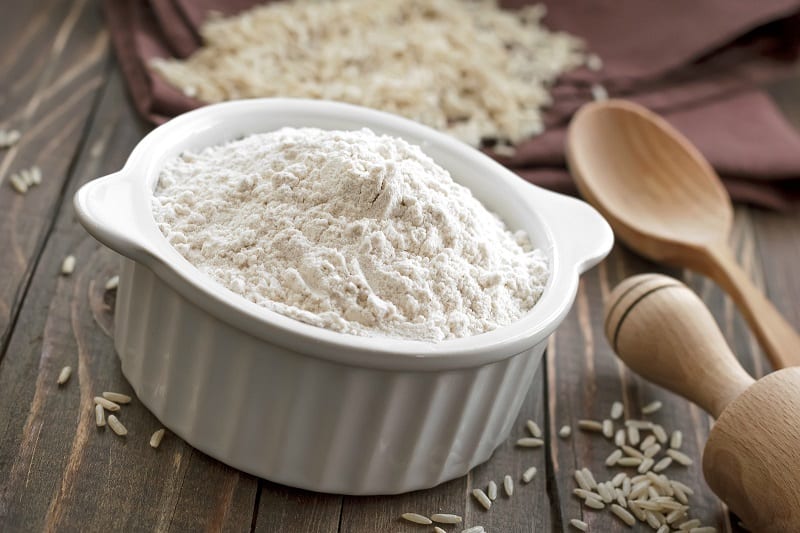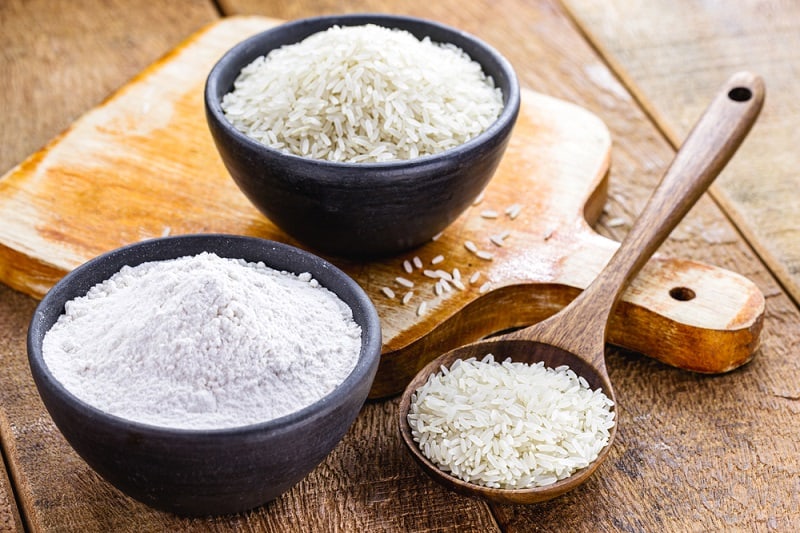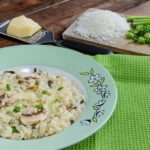Ground rice is exactly what it says on the tin: rice that has been ground down into a fine powder.
It is commonly used in baking recipes, especially gluten-free recipes that require an alternative to standard wheat flour that is typically used for baked goods.
It’s also commonly used for frying to create a lighter tempura-style batter.
However, ground rice isn’t that easy to come by in UK supermarkets and isn’t deemed a kitchen staple.
So, what can you use as a substitute for ground rice? There are a few options available that you might already have to hand which we explore in this article.
What Is the Best Substitute for Ground Rice?
Many products can be used as a substitute for ground rice.
You can use other types of flour, cornstarch, and potato starch!
But the best substitute depends on what dish you’re cooking. Here we look at three popular recipes that call for ground rice and the best easily-sourced alternatives you can pick up from your local supermarket.
Substituting for ground rice in shortbread recipes
Traditional shortbread recipes always call for ground rice. This type of flour provides a way of adding starch to the recipe without adding protein, lowering the overall protein content of the dough. It is this that gives shortbread biscuits their dry and delicate crumbly crunch.
Thankfully, you can easily replicate this by using a combination of all-purpose flour and cornstarch at a ratio of 3:1 in place of the ground rice.
Alternatively, semolina functions in the same way as cornstarch. Use 225g of plain flour and 100g of semolina like in this Mary Berry recipe for crunchy, buttery, and delicious shortbread biscuits.

Substituting for ground rice in Bakewell tart
Almond flour is one of the best gluten-free flours that can be used in any baked goods. However, it works particularly well in a Bakewell tart recipe.
All baked goods made with almond flour have a slightly nutty flavour, and almond and jam are the predominant flavours of this British classic.
Therefore, substituting ground rice for almond flour could even up-level your Bakewell tart recipe.
When using almond flour as a ground rice alternative, you can substitute in a ratio of 1:1. This means you can easily adjust your Bakewell tart recipe with little thought and effort.
Moreover, as a gluten-free flour, the finished tart will still be suitable for people with celiac disease. Almond flour also provides a good chunk of your daily vitamin E intake and other antioxidants.
If you’re not bothered about making a gluten-free pasty for your Bakewell, plain all-purpose wheat flour also works a charm.
You can also purchase special party blend flour that contains a lower amount of protein. This makes more delicate pastries for a lighter finish.

Substituting for ground rice when frying
When it comes to frying, ground rice is often used for a lighter batter and a less oily coating. This is because ground rice absorbs less oil than other flours, and thus produces a less fatty finished product.
It makes the perfect coating for Asian food such as Japanese tempura vegetables or Korean fried chicken. Fried calamari also comes out incredibly when fried in ground rice.
One of the best ground rice substitutes for frying is plain, all-purpose flour. If using all-purpose flour, ensure you add a little water to the mixture before coating the food you are frying.
This helps to keep the gluten inside the flour as it fries so the batter retains its light and crispy consistency.
If you’re after super-crispy fried food, potato starch is another great substitute. Simply mix two parts flour with one part potato starch and use this as a coating.
You can use pure potato starch as a last resort, but the texture usually comes out too crispy and hard.
Cornstarch is another good alternative and will produce a light yet crisp crust. In fact, it’s often used in Chinese recipes for this very reason.
What’s the Difference Between Ground Rice and Rice Flour?

Many people get confused by the difference between ground rice and rice flour, also known as rice powder.
The two sound similar, but where do the differences lie? And can rice flour be used as a substitute for ground rice?
As the name suggests, both ground rice and rice flour are made by milling down rice into a powder. However, ground rice is much coarser, whereas rice flour is much finer.
Therefore, the only difference between these two products lies in the texture. However, this does not mean the two are interchangeable and using the wrong one can dramatically alter the texture of your baked goods.
How Do You Make Ground Rice at Home?
If you cannot get your hands on any of the ground rice substitutes, you might want to consider making your own ground rice at home. The process is extremely easy and only requires one ingredient: rice! Follow these steps to make your own ground rice for baking and frying:
- Measure out the weight of ground rice your recipe calls for in uncooked rice
- Place a small amount of this uncooked rice in a blender and grind until it becomes a powder
- Repeat with more of the uncooked rice until it is all ground into a powder
- Use this blended rice as a replacement for ground rice in any recipe
You can use this method with any variety of rice you have in your kitchen cupboards. Brown rice has a denser and earthier taste, while white rice is lighter and fluffier.
You can also use the same method for any recipe that requires rice flour. Just blend the uncooked rice a little longer until no lumps are remaining.

Hannah is a freelance content writer and self-proclaimed foodie. When Hannah isn’t sitting tapping at her laptop, you’ll probably find her in the kitchen. As an ex-chalet host, she’s used to cooking four-course meals for 10+ people and loves feeding friends and family whenever possible.







